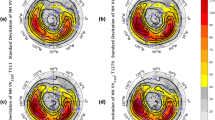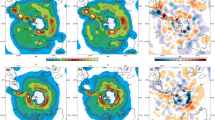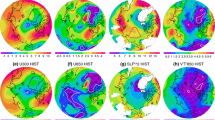Abstract
Northern Hemisphere winter storm tracks are a key element of the winter weather and climate at mid-latitudes. Before projections of climate change are made for these regions, it is necessary to be sure that climate models are able to reproduce the main features of observed storm tracks. The simulated storm tracks are assessed for a variety of Hadley Centre models and are shown to be well modelled on the whole. The atmosphere-only model with the semi-Lagrangian dynamical core produces generally more realistic storm tracks than the model with the Eulerian dynamical core, provided the horizontal resolution is high enough. The two models respond in different ways to changes in horizontal resolution: the model with the semi-Lagrangian dynamical core has much reduced frequency and strength of cyclonic features at lower resolution due to reduced transient eddy kinetic energy. The model with Eulerian dynamical core displays much smaller changes in frequency and strength of features with changes in horizontal resolution, but the location of the storm tracks as well as secondary development are sensitive to resolution. Coupling the atmosphere-only model (with semi-Lagrangian dynamical core) to an ocean model seems to affect the storm tracks largely via errors in the tropical representation. For instance a cold SST bias in the Pacific and a lack of ENSO variability lead to large changes in the Pacific storm track. Extratropical SST biases appear to have a more localised effect on the storm tracks.
















Similar content being viewed by others
Notes
Note that, when comparing with ERA15, Ringer et al. (2006) found that HadGAM1 underestimated the TEKE in the storm track regions. We have analysed the energy cycle in both ERA15 and ERA40 and find that both the TAPE and TEKE are smaller in ERA40 than in ERA15. This is unexpected given that the horizontal resolution of ERA40 is higher than that of ERA15 and may suggest the presence of noise in ERA15. Ultimately, it should be remembered that approximations are made in these calculations and while qualitative comparisons can be used as an aid to interpretation, quantitative comparisons should be viewed with caution.
References
Anderson D (2000) Feature tracking validation of storm tracks in model data. PhD Thesis, University of Reading, Reading, UK
Bengtsson L, Hodges KI, Roeckner E (2006) Storm tracks and climate change. J Clim 19:3518–3543
Blackmon ML (1976) A climatological spectral study of the 500 mb geopotential height of the Northern Hemisphere. J Atmos Sci 33:1607–1623
Blender R, Fraedrich K, Lunkeit F (1997) Identification of cyclone-track regimes in the North Atlantic. Q J R Meteorol Soc 123:727–741
Chang EKM, Lee SY, Swanson KL (2002) Storm track dynamics. J. Clim 15:2163–2183
Chen M, Rood RB, Takacs LL (1997) Impact of a semi-Lagrangian and an Eulerian dynamical core on climate simulations. J Clim 10:2374–2389
Compo GP, Sardeshmukh PD, Penland C (2001) Changes of subseasonal variability associated with El Niño. J Clim 14:3356–3374
Ferranti L, Molteni F, Palmer TN (1994) Impact of localized tropical and extratropical SST anomalies in ensembles of seasonal GCM integrations. Q J R Meteorol Soc 120:1613–1645
Gates WL, Co-authors (1999) An overview of the results of the Atmospheric Model Intercomparison Project (AMIP I). Bull Am Meteor Soc 80:29–55
Gibson JK, Källberg P, Uppala S, Hernandez A, Nomura A, Serrano E (1997) ERA description. ECMWF Re-analysis Project Report Series, No. 1, ECMWF, Reading, United Kingdom, 71 pp
Gordon C, Cooper C, Senior CA, Banks H, Gregory JM, Johns TJ, Mitchell JFB, Wood RA (2000) The simulation of SST, sea ice extents and ocean heat transports in a version of the Hadley Centre coupled model without flux adjustments. Clim Dyn 16:147–168
Hodges KI (1994) A general method for tracking analysis and its application to meteorological data. Mon Wea Rev 122:2573–2586
Hodges KI (1995) Feature tracking on the Unit Sphere. Mon Wea Rev 123:3458–3465
Hodges KI (1999) Adaptive constraints for feature tracking. Mon Wea Rev 127:1362-1373
Hodges KI, Hoskins BJ, Boyle J, Thorncroft C (2003) A comparison of recent reanalysis datasets using objective feature tracking: Storm tracks and tropical easterly waves. Mon Wea Rev 131:2012–2037
Hoskins BJ, Hodges KI (2002) New perspectives on the Northern Hemisphere winter storm tracks. J Atmos Sci 59:1041–1061
Hoskins BJ, Valdes PJ (1990) On the existence of storm-tracks. J Atmos Sci 47:1854–1864
Hoskins BJ, Hsu HH, James IN, Masutani M, Sardeshmukh PD, White GH (1989) Diagnostics of the global atmospheric circulation based on ECMWF analyses 1979-1989. UGAMP Tech. Rep. No. 7. [Available from Department of Meteorology, University of Reading, Earley Gate, PO Box 243, Reading, RG6 6BB, UK]
James IN (1994) Introduction to circulating atmospheres, 1st edn. Cambridge University Press, Cambridge
James PM (2006) An assessment of European synoptic variability in Hadley Centre Global Environmental Models based on an objective classification of weather regimes. Clim Dyn 27:215–231
Johns TC, Durman CF, Banks HT, Roberts MJ, McLaren AJ, Ridley JK, Senior CA, Williams KD, Jones A, Rickard GJ, Cusack S, Ingram WJ, Sexton DMH, Joshi MM, Dong B-W, Spencer H, Hill RSR, Gregory JM, Keen AB, Pardaens AK, Lowe JA, Bodas-Salcedo A, Stark S, Searl Y (2006) The new Hadley Centre climate model HadGEM1: Evaluation of coupled simulations. J Clim 19:1327–1353
Lambert SJ, Sheng J, Boyle J (2002) Winter cyclone frequencies in thirteen models participating in the Atmospheric Model Intercomparison Project (AMIP1). Clim Dyn 19:1–16
Lindzen RS, Farrell B (1980) A simple approximate result for the maximum growth rate of baroclinic instabilities. J Atmos Sci 37:1648–1654
Martin GM, Ringer MA, Pope VD, Jones A, Dearden C, Hinton TJ (2006) The physical properties of the atmosphere in the new Hadley Centre Global Environmental Model, HadGEM1. Part 1: Model description and global climatology. J Clim 19:1274–1301
McDonald RE (2006) Future changes in northern hemisphere extratropical cyclones (in preparation)
Murray RJ, Simmonds I (1991) A numerical scheme for tracking cyclone centres from digital data. Part I: development and operation of the scheme. Aust Meteor Mag 39:155–166
Pope VD, Stratton RA (2002) The processes governing horizontal resolution sensitivity in a climate model. Clim Dyn 19:211–236
Pope VD, Gallani ML, Rowntree PR, Stratton RA (2000) The impact of new physical parametrizations in the Hadley Centre climate model: HadAM3. Clim Dyn 16:123–146
Pope VD, Pamment JA, Jackson DR, Slingo A (2001) The representation of water vapor and its dependence on vertical resolution in the Hadley Centre Climate Model. J Clim 14:3065–3085
Raible CC, Blender R (2004) Northern Hemisphere midlatitude cyclone variability in GCM simulations with different ocean representations. Clim Dyn 22:239–248
Ringer MA, Martin GM, Greeves CZ, Hinton TJ, James PM, Pope VD, Scaife AA, Stratton RA, Inness PM, Slingo JM, Yang G-Y (2006) The physical properties of the atmosphere in the new Hadley Centre Global Environmental Model, HadGEM1. Part 2: aspects of variability and regional climate. J Clim 19:1302–1326
Siegmund P (1995) The generation of available potential energy: a comparison of results from a general circulation model with observations. Clim Dyn 11:129–140
Simmons AJ, Gibson JK (2000) The ERA-40 Project Plan, ERA-40 Project Report Series, No. 1. ECMWF, Reading, UK, 63 pp
Stratton RA (1999) A high resolution AMIP integration using the Hadley Centre model HadAM2b. Clim Dyn 15:9–28
Stratton RA (2004a) The energetics of a semi-Lagrangian dynamical core. Unpublished Hadley Centre Technical Note No. 52. Available at http://www.met-office.gov.uk/research/hadleycentre/pubs/HCTN/index.html
Stratton RA (2004b) Reports on aspects of variability in high-resolution versions of HadAM3. Unpublished Hadley Centre Technical Note No. 53. Available at http://www.met-office.gov.uk/research/hadleycentre/pubs/HCTN/index.html
Trigo IF, Bigg GR, Davies TD (2002) Climatology of cyclogenesis mechanisms in the Mediterranean. Mon Wea Rev 130:549–569
Ulrich U, Speth P (1991) The global energy cycle of stationary and transient atmospheric waves: Results from ECMWF analyses. Meteorol Atmos Phys 45:125–138
Wallace JM, Lim GH, Blackmon ML (1988) Relationship between cyclone tracks, anticyclone tracks and baroclinic waveguides. J Atmos Sci 45:439–462
Zhu WJ, Sun ZB (1999) Influence of ENSO event on the maintenance of Pacific storm track in the northern winter. Adv Atmos Sci 16(4):630–640
Acknowledgments
This work was funded by the UK Government Meteorological Research programme. The authors would like to thank Kevin Hodges for his help and for the use of the TRACK software. Assistance from Ruth McDonald is also gratefully acknowledged and help from Mark Ringer is appreciated. The development of HadGEM1 and HadAM3 represents the work of a large number of people to whom the authors are indebted. Useful comments from two anonymous reviewers are also much appreciated.
Author information
Authors and Affiliations
Corresponding author
Rights and permissions
About this article
Cite this article
Greeves, C.Z., Pope, V.D., Stratton, R.A. et al. Representation of Northern Hemisphere winter storm tracks in climate models. Clim Dyn 28, 683–702 (2007). https://doi.org/10.1007/s00382-006-0205-x
Received:
Accepted:
Published:
Issue Date:
DOI: https://doi.org/10.1007/s00382-006-0205-x




